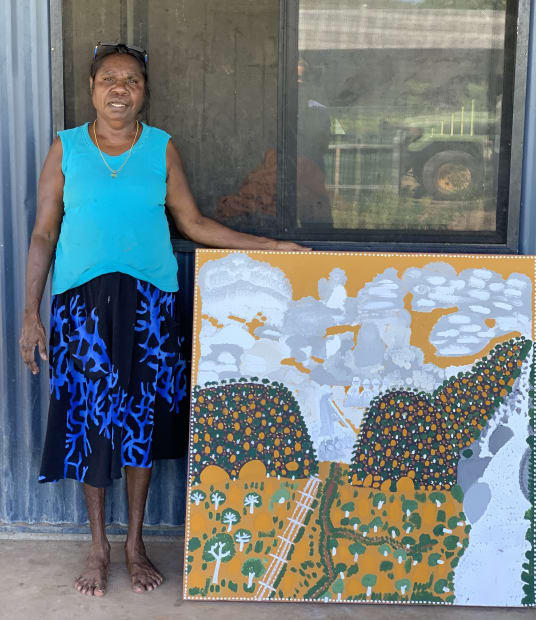-
Tracey and Kathy Ramsay - Juwurlinji
-

-

-
Enquire
-
 Kathy Ramsay, Bow River Bridge, 2020
Kathy Ramsay, Bow River Bridge, 2020 -
 Kathy Ramsay, Bow River Country, 2020
Kathy Ramsay, Bow River Country, 2020 -
 Kathy Ramsay, Dick's Yard, 2020
Kathy Ramsay, Dick's Yard, 2020 -
 Kathy Ramsay, Greenvale Station, 2020
Kathy Ramsay, Greenvale Station, 2020
-
 Kathy Ramsay, Greenvale, 2020
Kathy Ramsay, Greenvale, 2020 -
 Kathy Ramsay, Greenvale Station, 2020
Kathy Ramsay, Greenvale Station, 2020 -
 Kathy Ramsay, Rhatingan's Yard, 2020
Kathy Ramsay, Rhatingan's Yard, 2020 -
 Tracey Ramsay, Black Hill, 2020
Tracey Ramsay, Black Hill, 2020
-
-

-
-
To Kathy, the older of the two sisters, artistic expression is both a way of connecting with her heritage and paying homage to the land, which is known in Gija as Juwurlinji (the exhibition’s title). ‘I just paint what my old people told me about our Country – because they are the ones who know the history of our Country, the Country we’re still connected to today. Our Country really knows us, and it owns us,’ commented Kathy. In this way, the works gain a deeply symbolic resonance as they transcend not just time but also the notion of singularity. Through the use of simple forms and blocks of colour, the artist knowingly speaks to her community’s collective dialogue and identity, whilst also creating a sense of universal familiarity.
Similarly, Tracey employs the same flattened, graphical aesthetic to create a layered and psychological perspective of place. Though Tracey began painting later than Kathy, at the age of 47, the visual affinity of their work in both style and subject-matter (they often paint the same geographical sites) again demonstrates the presence of a larger collective, innate narrative. The warm, earthy tones used by both artists are made from natural pigments, completing the
-
cyclical creative process which begins and ends with the land, whilst also evoking the natural light and climate. This distinct atmospheric quality is heightened by the eye-catching electric blue of the river which weaves across the artists’ canvases, carving the shape of the land and guiding the viewer’s gaze. Similarly, the artists employ white dots to delineate shapes, drawing on a historic aesthetic trait of both the region’s art and culture. ‘The white dots are traditionally used by Aboriginal people. We also use them in corroborees [dance ceremonies] when we trace them around our faces. It’s beautiful. It brings out the flavour of your painting, culture and dance,’ explains Kathy.
Viewed together, subtle differences in the artist’s visual language become clear, revealing their personal perspectives and experiences, whilst also creating a satisfying sense of wholeness. Juwurlinji is a richly atmospheric and layered narrative of a land and its people as it endures and evolves in the present.
-
-
Tracey and Kathy Ramsay
Past viewing_room

















